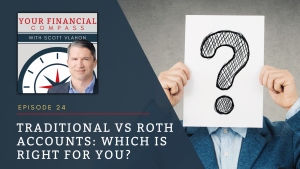Retirement marks a significant transition from accumulating wealth to preserving it to support your lifestyle without a predictable income from an employer or business. Once retired, you’ll begin relying on different income sources, such as retirement savings, Social Security, and investments.
As you start drawing on your savings, hopefully, you have already determined a retirement withdrawal strategy that outlines how you will access your funds throughout your retirement years to support your desired lifestyle.
A retirement withdrawal strategy should be part of your comprehensive retirement plan, so you can aim to have a sustainable financial strategy to ensure your accumulated assets last the rest of your life. With a well-thought-out withdrawal strategy, you can aim to preserve your assets for your cost of living later in life.
Your primary goal should be striking the right balance between enjoying your retirement years and maintaining your financial security later in life while aiming to ensure you are not putting yourself at risk for a large tax bill.
Our team of Roseville retirement planning professionals focus on developing retirement withdrawal strategies for successful individuals who have accumulated substantial wealth for their retirement years.
In our blog, we’ll explain a retirement withdrawal strategy and provide examples of how you can implement one for your retirement assets.
What is a Retirement Withdrawal Strategy?
Simply put, a retirement withdrawal strategy outlines how to take money out of your retirement, savings, and Social Security accounts to cover your living expenses once you’re no longer working. The right strategy balances your immediate financial needs with the necessity to keep your funds growing while managing the risk of outliving your savings.
One example is the 4% rule, where you withdraw 4% of your retirement in the first year and adjust that amount for inflation in subsequent years. This strategy aims to provide a steady income stream while minimizing the risk of depleting your savings too early.
Listen to our new podcast, “Important Age Milestones for Your Retirement.”
For illustration purposes, let’s say you’ve saved $500,000 for retirement. Using the 4% withdrawal strategy, you’d withdraw $20,000 in the first year. In each subsequent year, you’d adjust your withdrawals for inflation, so if inflation is 3%, you’d withdraw $20,600 the following year to protect your standard of living.
This strategy balances the need for income while maintaining your savings throughout retirement. It’s a guideline, and your specific withdrawals might vary based on your expenses, investment returns, risk tolerance, and other personal factors.
Another example is the bucket strategy, which involves dividing your savings into “buckets” earmarked for different phases of retirement.
The first bucket might contain cash and cash equivalents for immediate expenses and unexpected events. The second bucket could have intermediate fixed-income investments, and a third might hold stocks and other growth-oriented investments for the long term. This approach balances immediate income needs with longer-term growth potential and tolerance for investment risk.
IRS mandates can also drive another strategy: Required Minimum Distributions (RMDs). The IRS requires minimum withdrawals for certain retirement accounts starting at age 72. Your RMDs could form the core of your withdrawal strategy, supplemented by other sources as needed.
Watch our founder, Chris Bulman, discuss navigating your financial success using a Financial Roadmap.
Retirement Withdrawal Penalties
Another factor to be aware of is the potential penalties for withdrawing funds earlier than the IRS rules allow. These penalties are in place to discourage the use of retirement savings for purposes other than producing retirement income, aiming to ensure these funds remain available to support individuals in their latter years.
For traditional accounts like 401(k)s and IRAs, if you withdraw before the age of 59½, this typically triggers a 10% penalty on the amount withdrawn, in addition to being subject to regular income taxes.
However, certain exceptions, such as withdrawals for qualified medical expenses or a first-time home purchase, can avoid the penalty.
For Roth IRAs, contributions (but not earnings) can often be withdrawn tax and penalty-free at any time. Still, early withdrawal of earnings may incur penalties and taxes, depending on the account’s age and the purpose of the withdrawal. It pays to talk to an experienced professional about this strategy.
Taxation of Retirement Withdrawals
When you withdraw funds from retirement accounts, the tax treatment depends on the type of account. Each type of account has specific rules and conditions, such as Required Minimum Distributions (RMDs) starting at specific ages.
Here’s a brief rundown of how taxes apply to your retirement withdrawals:
- Traditional IRA and 401(k) Plans: The withdrawal of these accounts is typically taxed as ordinary income. Since contributions are made with pre-tax dollars, taxes are deferred until funds are withdrawn.
- Roth IRA and Roth 401(k) Plans: Contributions to these accounts are made with after-tax dollars, so withdrawals are generally tax-free, provided certain conditions are met, such as the account is at least five years old and withdrawals are being made after the age of 59½.
- SEP IRA and SIMPLE IRA: Similar to traditional IRAs, withdrawals are taxed as ordinary income. These plans are designed for self-employed individuals and small businesses, allowing higher contribution limits.
- 401(a) and 403(b) Plans: These accounts are often used by government and non-profit employees, and withdrawals are taxed as ordinary income. Contributions to these plans can be either pre-tax or after-tax, depending on the plan’s design characteristics.
- Roth IRAs: Withdrawals from Roth IRAs are often tax-free, a significant trait for many investors. When you contribute to a Roth IRA, you use after-tax dollars, meaning you’ve already paid taxes on the money you’re putting in. As a result, when you start withdrawing funds, the money, including appreciation and income, can be taken out tax-free, provided certain conditions are met.
Two key conditions must be satisfied for a withdrawal to be tax-free: the account must be at least five years old, and the withdrawal must be made after the account holder is 59 ½ years old, is disabled, is purchasing a first home (up to a $ 10,000-lifetime limit), or the withdrawal is made to a beneficiary or estate after the account holder’s death.
If these conditions are not met, non-qualified withdrawals may be subject to income taxes and a 10% early withdrawal penalty on the earnings portion of the withdrawal. Contributions can generally be withdrawn without taxes or penalties because they were made with after-tax dollars.
Make the most out of your retirement income planning with the assistance of a Financial Roadmap from Bulman Wealth Group.
Why Consider Bulman Wealth Advisors?
With over 20 years of experience developing comprehensive financial and retirement plans, we help our clients pursue their dream retirements. It’s more than just savings, investing, and withdrawal strategies. We also focus on a more holistic approach that includes achieving goals, managing risk, and creating legacies for future generations.
To learn more about our retirement withdrawal strategies, connect with us to schedule an introductory call.
All content is for information purposes only. It is not intended to provide any tax or legal advice or provide the basis for any financial decisions. Nor is it intended to be a projection of current or future performance or an indication of future results.
Opinions expressed herein are solely those of Chris Bulman Inc. dba Bulman Wealth Group and our editorial staff. The information contained in this material has been derived from sources believed to be reliable but is not guaranteed as to accuracy and completeness and does not purport to be a complete analysis of the materials discussed. All information and ideas should be discussed in detail with your individual advisor prior to implementation. Investment advisory services are offered through Chris Bulman Inc dba Bulman Wealth Group, an SEC Registered Investment Advisor. Insurance products and services are offered through Chris Bulman, Inc. dba BWG Insurance Agency and Ameritas Life Insurance Corp., CA State Insurance License # 0M46922. Being registered as an investment advisor does not imply a certain level of skill or training.
Bulman Wealth Group, BWG Insurance Agency and Ameritas Life Insurance Corp. are not affiliated with or endorsed by the Social Security Administration or any other government agency.
Any statements or opinions expressed should in no way be construed or interpreted as a solicitation to sell, or offer to sell, advisory services to any residents of any State other than the States where otherwise legally permitted.
Images and photographs are included for the sole purpose of visually enhancing the website. None of them are photographs of current or former Clients. They should not be construed as an endorsement or testimonial from any of the persons in the photograph.
Purchases are subject to suitability. This requires a review of an investor’s objective, risk tolerance, and time horizons. Investing always involves risk and possible loss of capital.








